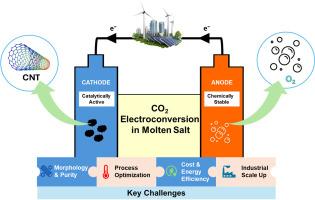Electrode materials for electrochemical synthesis of carbon nanotube from CO2: Surface properties, mechanisms, and perspectives
IF 8.7
Q1 CHEMISTRY, PHYSICAL
引用次数: 0
Abstract
Carbon nanotubes (CNTs) are nanomaterials with exceptional electrical, thermal, and mechanical properties, making them highly attractive for advanced technological applications. While conventional synthesis methods, such as chemical vapor deposition (CVD) are well-established for large-scale CNT production, molten salt electrolysis has emerged as an alternative pathway that simultaneously enables CO2 utilization and potential energy saving. This review highlights recent developments in the electrochemical synthesis of CNTs via molten salt systems, with particular emphasis on the surface properties and roles of electrode materials. Various electrode materials, including metals, alloys, metal oxides, graphite, and liquid metals, are critically analyzed based on their catalytic activity, carbon–metal interactions, and influence on carbon morphology. In addition, the criteria for stable anode materials under oxygen evolution conditions are discussed. The review also addresses major challenges, including CNT purity and structural control, scaling up the process for industrial applications, and enhancing energy efficiency. By consolidating recent progress and identifying key knowledge gaps, this work aims to guide future innovation in the rational design of electrode materials for sustainable CNT production via electrochemical CO2 conversion.

用CO2电化学合成碳纳米管的电极材料:表面性质、机理和前景
碳纳米管(CNTs)是一种具有优异的电学、热学和机械性能的纳米材料,在先进技术应用中具有很高的吸引力。虽然传统的合成方法,如化学气相沉积(CVD)已被广泛用于大规模碳纳米管生产,但熔盐电解已成为同时实现二氧化碳利用和潜在节能的替代途径。本文综述了通过熔盐体系电化学合成碳纳米管的最新进展,特别强调了电极材料的表面性质和作用。各种电极材料,包括金属、合金、金属氧化物、石墨和液态金属,根据它们的催化活性、碳-金属相互作用和对碳形态的影响进行了严格的分析。此外,还讨论了析氧条件下稳定阳极材料的判据。该综述还解决了主要挑战,包括碳纳米管纯度和结构控制,扩大工业应用的过程,以及提高能源效率。通过巩固最近的进展和确定关键的知识差距,这项工作旨在指导未来通过电化学二氧化碳转化实现可持续碳纳米管生产的电极材料的合理设计创新。
本文章由计算机程序翻译,如有差异,请以英文原文为准。
求助全文
约1分钟内获得全文
求助全文

 求助内容:
求助内容: 应助结果提醒方式:
应助结果提醒方式:


